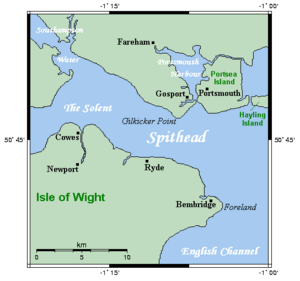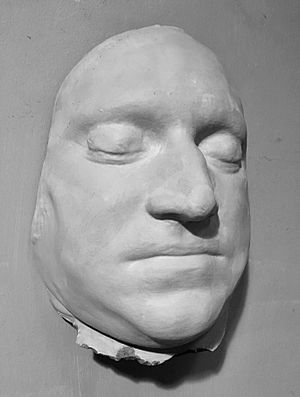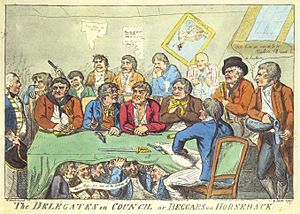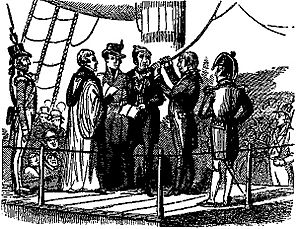Spithead and Nore mutinies facts for kids
The Spithead and Nore Mutinies were two big rebellions by sailors in the Royal Navy in 1797. These events were a serious worry for Britain. At the time, the country was fighting a war against Revolutionary France. The Navy was super important for winning that war. Even though these mutinies happened close together, they were quite different. The Spithead mutiny was a peaceful and successful strike action. Sailors wanted better pay and conditions. The Nore mutiny was more extreme. It involved political ideas and ended up failing.
Contents
The Spithead Mutiny

The mutiny at Spithead happened near Portsmouth. It lasted from April 16 to May 15, 1797. Sailors on 16 ships in the Channel Fleet protested their living conditions. They demanded more pay, better food, and more time off shore. They also wanted help if they got sick or hurt. On April 26, sailors on 15 ships in Plymouth also mutinied to support them. They sent representatives to Spithead to join the talks.
Why Sailors Were Unhappy
Sailors' pay had not changed since 1658. While this pay was fair during the Seven Years' War (1756–1763), prices had gone up a lot by the late 1700s. This meant their pay was worth much less. Soldiers and naval officers had recently received pay raises, but sailors had not. Also, ships now had copper on their bottoms. This meant they did not need to return to port as often. Sailors spent much more time at sea, making their work harder. The Royal Navy had not adjusted to these changes.
Another issue was Impressment. This was when men were forced to join the Navy, even if they did not want to. Also, a new system meant that many new sailors were "landsmen." These were people from inland areas, sometimes even criminals sent instead of punishment. They did not get along well with experienced sailors. This caused more unhappiness on the ships.
Negotiations and Resolution
The mutineers chose leaders to represent them. They tried to talk with the Admiralty for two weeks. Their main demands were for better pay and to stop the "purser's pound." This was a trick where the ship's purser (the person in charge of supplies) would give sailors less meat than they were supposed to get. They also wanted some unpopular officers removed. The sailors did not demand an end to impressment or flogging (a harsh punishment).
The mutineers kept things orderly on their ships. They even let some ships leave for important duties. They promised to stop the mutiny and sail if French ships were seen heading for England.
Talks broke down because of a lack of trust, especially about pardons for the mutineers. Some unpopular officers were sent ashore. But then, Admiral Lord Howe stepped in. He helped reach an agreement. All the crews received a royal pardon. Some unpopular officers were moved to other ships. Sailors got a pay raise, and the "purser's pound" was stopped. After this, the Spithead mutiny was sometimes called the "breeze at Spithead" because it ended peacefully.
The Nore Mutiny
Inspired by the Spithead sailors, sailors at the Nore also mutinied. The Nore was an anchorage in the Thames Estuary. On May 12, 1797, the crew of Sandwich took control of their ship. Other ships nearby followed. However, some ships managed to escape the mutiny. The mutineers chose leaders for each ship.
Richard Parker and Demands
Richard Parker was chosen as the "President of the Delegates of the Fleet." He had been a naval officer but was demoted. He rejoined the Navy as a regular sailor. On May 20, 1797, the mutineers gave Admiral Charles Buckner a list of eight demands. These included pardons, more pay, and changes to the Navy's rules. They even demanded that the King dissolve Parliament and make peace with France.
The Admiralty was very angry about these demands. They offered only a pardon and the same improvements already given at Spithead. They wanted the sailors to return to duty right away.
End of the Nore Mutiny
Captain Sir Erasmus Gower gathered a group of loyal ships. They aimed to stop the mutineers from moving towards London. This threat made the mutineers start to rethink their actions.
The mutineers also tried to blockade London. They stopped merchant ships from entering the port. Some leaders even planned to sail their ships to France. This idea made many English sailors unhappy. More and more ships left the mutiny. The Admiralty worried that ships at sea might go to France, but this rarely happened. For example, when the crew of HMS Galatea (1794) mutinied, they still followed orders to return to Plymouth. They just wanted better conditions, not to betray their country.
On June 5, Parker allowed merchant ships to pass the blockade. He said it would make people on shore think better of them. But it was also very hard to stop all the ships on the busy Thames. After the Spithead mutiny ended well, the government did not want to give in to more demands. They felt the Nore leaders had political goals, not just better pay.
The mutineers were cut off from food and water. When Parker signaled for the ships to sail to France, none of the remaining ships followed. Captain Charles Cunningham of HMS Clyde convinced his crew to return to duty and sailed away. This encouraged others to do the same. Most ships eventually left the mutiny, some even under fire from the mutineers.
The mutiny failed. Richard Parker was found guilty of treason and piracy. He was hanged from the yardarm of the Sandwich, the ship where the mutiny began. After the mutiny, 29 sailors were hanged, 29 were imprisoned, and nine were flogged. Others were sent to Australia. Most sailors involved were not punished, which was quite lenient for that time.

Mutinies That Followed
After Spithead and the Nore, other mutinies happened. In September 1797, the crew of Hermione mutinied in the West Indies. They killed almost all the officers because of harsh treatment. The crew took the Hermione to a Spanish port.
On December 27, the crew of Marie Antoinette also killed their officers. They took their ship to a French port. More mutinies happened off Ireland and at the Cape of Good Hope. They even spread to Admiral Jervis's fleet off Spain. On HMS Defiance, eleven men were sentenced to hang for taking oaths to the United Irishmen, a political group.
In the years after Spithead and the Nore, mutinies in European navies and merchant ships increased by about 50%. Experts think this was linked to new political ideas at the time. It also showed that sailors were starting to feel like a united group with shared problems.
In the Arts
- The father of the main character in Frederick Marryat's book The King's Own (1830) was hanged for his part in the Nore mutiny.
- Herman Melville's novel Billy Budd (published 1924) and the 1951 opera by Benjamin Britten are set right after these mutinies.
- The Floating Republic – An account of the Mutinies at Spithead and The Nore in 1797 by G. E. Manwaring and Bonamy Dobrée is a history book about these events.
- Ramage and the Freebooters (1969) by Dudley Pope starts with Lieutenant Ramage commanding a ship at Spithead during the mutiny. He has to convince his crew to sail.
- The English folk-punk band The Men They Couldn't Hang remembered the mutiny leaders in their song "The Colours" (1988).
- In William Kinsolving's 1996 novel Mister Christian, Fletcher Christian returns and sees the Nore mutiny.
- Much of Dewey Lambdin's 2000 novel A King's Captain takes place during the Nore Mutiny.
- Mutiny (2004) by Julian Stockwin is a fictional story about the Nore mutiny.



